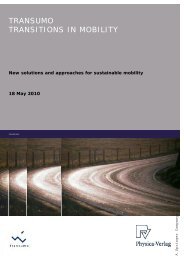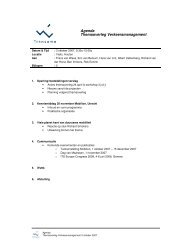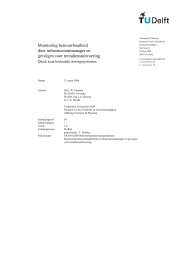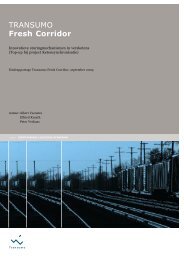Casestudie Breakdown prediction Contell PILOT - Transumo
Casestudie Breakdown prediction Contell PILOT - Transumo
Casestudie Breakdown prediction Contell PILOT - Transumo
Create successful ePaper yourself
Turn your PDF publications into a flip-book with our unique Google optimized e-Paper software.
MTBF<br />
Availability =<br />
MTBF + MTTR<br />
Formula 5-10: The Definition of Availability [Masing88]<br />
The general idea, to calculate the estimated availability during a specified time,<br />
seems to be promising. But this method of failure- and availability ratios is faced with<br />
a major problem, when applying it to the setting of sensor based temperature<br />
monitoring. Most manufacturers of cooling devices do not offer ratios like MTTF<br />
[Nijmegen06]. As cooling devices are long-life products, a determination of these<br />
measures is also impossible. Hence, the appliance of failure- and availability ratios is<br />
not applicable within the setting of sensor based temperature monitoring.<br />
5.7 Markov Chains<br />
Another approach of predicting breakdowns is the usage of Markov chains. These<br />
chains are simple time-discrete stochastic processes (<br />
n<br />
)<br />
n N0<br />
X ∈<br />
with a countable state<br />
space I that comply with the following Formula 5-11 for all points in time n∈ N<br />
0<br />
and<br />
all states<br />
i ,K,<br />
i , i i ∈ I : ([Waldmann04], p. 11)<br />
0 n−1<br />
n,<br />
n+<br />
1<br />
P X i | X = i , , X = i , X = i ) = P(<br />
X = i | X = i<br />
(<br />
n+ 1<br />
=<br />
n+<br />
1 0 0<br />
K<br />
n−1<br />
n−1<br />
n n<br />
n+<br />
1 n+<br />
1 n n<br />
Formula 5-11: The Markov Property<br />
)<br />
This Markov property is the specific characteristic of Markov chains. It says that the<br />
probability for changing to another state is only influenced by the last observed state<br />
and not by prior ones. Hence, the probability that X<br />
n+ 1<br />
takes the value i<br />
n+ 1<br />
is only<br />
influenced by<br />
i n<br />
∈ I and not by i ,K in ∈ I . ([Waldmann04], p. 11)<br />
0<br />
,<br />
−1<br />
The conditional probability P ( X<br />
n + 1<br />
= in<br />
+ 1<br />
| X<br />
n<br />
= in<br />
) is called the processes’ transition<br />
probability. If this transition probability is independent from the point in time n , the<br />
Markov chain is called homogeneous. Otherwise it is called inhomogeneous<br />
([Waldmann04], p. 11). In the following, this thesis will first of all focus on<br />
homogeneous Markov chains. To improve the readability, they will just be named<br />
Markov chains.<br />
In the majority of cases the transition probability is written as a matrix P . It contains<br />
the probabilities p<br />
ij<br />
of all possible changes between old state i and new state j as<br />
68
















